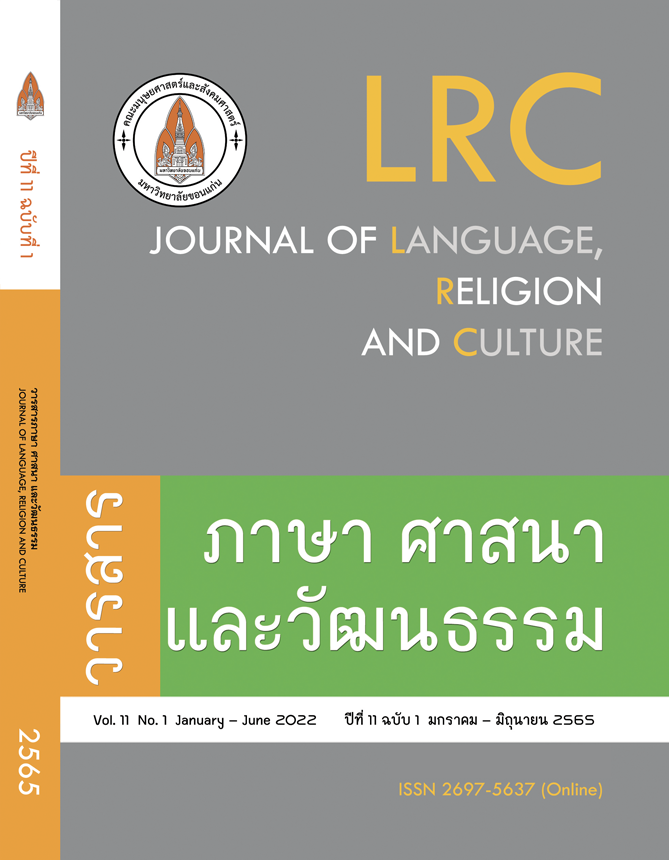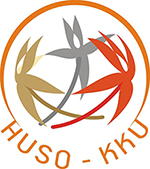การใช้คำคุณศัพท์ภาษาเยอรมันในการแปลงานวรรณกรรมในแง่มุมทางด้านความเชื่อทางศาสนาและวัฒนธรรม
การใช้คำคุณศัพท์ภาษาเยอรมันในการแปลงานวรรณกรรมในแง่มุมทางด้านความเชื่อทางศาสนาและวัฒนธรรม
คำสำคัญ:
Adjective, Translation, Religious Belief, Culture, คำคุณศัพท์, การแปล, ความเชื่อทางศาสนา, วัฒนธรรมบทคัดย่อ
บทความนี้มุ่งศึกษาการใช้คำคุณศัพท์ภาษาเยอรมันในการแปลงานวรรณกรรมในแง่มุมทางด้านความเชื่อทางศาสนาและวัฒนธรรม ผู้เขียนศึกษาจากงานแปลนิทานพื้นบ้านเรื่อง ผาแดง นางไอ่ โดยรวบรวมคำคุณศัพท์ที่บ่งชี้ความหมายทางด้านความเชื่อทางศาสนาและวัฒนธรรม ดังนั้นการวิเคราะห์ในการศึกษาครั้งนี้เป็นการวิเคราะห์ข้อมูลเชิงคุณภาพตามกรอบแนวคิดของการศึกษา ซึ่งนำไปสู่ข้อสรุปได้ว่าคำคุณศัพท์ที่นำมาศึกษาในบทความนี้มีหน้าที่ทั้งทางด้านภาษาศาสตร์และทางด้านการสื่อสาร ทางด้านภาษาศาสตร์นั้น สามารถศึกษาวิเคราะห์ได้ว่าคำคุณศัพท์สื่อความหมายอย่างไรในการแปลข้ามวัฒนธรรม ส่วนทางด้านการสื่อสารนั้น คำคุณศัพท์บ่งชี้ทัศนคติใดบ้างที่สามารถสะท้อนผ่านตัวบทแปลให้เป็นไปตามเจตนารมณ์ของผู้แปล นอกจากนี้ ผู้เขียนบทความได้ให้ข้อเสนอแนะในการนำผลการศึกษาไปชยายผลทั้งในแง่มุมทางด้านภาษาศาสตร์และการสอนภาษา
เอกสารอ้างอิง
Albrecht, J. (2013). Übersetzung und Linguistik. 2. Auflage. Tübingen: Narr Francke Attempto Verlag.
Becker, L, Sprache und Rhetorik der Emotion im Partnererwerbungsgespräch. Tübingen:
Narr Francke Attempto Verlag.
Bohnenkamp, A. (2015). Hybrid statt verfremdend? Überlegungen zu einem Topos der
Übersetzungstheorie. In Colliander, P., Hansen, D. & Zint-Dyhr, I. (Hrsg.) Linguistische Aspekte der Übersetzungswissenschaft. Tübingen: Stauffenburg Verlag.
Duden. (2006). Die Grammatik. Mannheim: Dudenverlag.
House, J. (2003). Übersetzen und Missverständnis. In Wierlacher, A., Ehrlich, K., Eichinger,
L.M., Kelletat, A. F., Michel, W. & Bohrer, K. (Hrsg.) Jahrbuch Deutsch als Fremdsprache.Intercultural German Studies. München: Iudicium.
Koller, W. (2011). Einführung in die Übersetzungswissenschaft. Tübingen: Narr Francke
Attempto Verlag GmbH & Co.KG .
König, K. & Gast, V. (2012) Understanding English-German Contrasts. Berlin: Erich
Schmidt Verlag.
Langenscheidt. (2013). Taschenwörterbuch Englisch. Berlin und München: Langenscheidt KG.
Müller, F. (2011). Interkulturelle Kommunikation: Einfluss kontextuellr und kultureller
Faktoren auf die interpersonelle Kommunikation zwischen Deutschen und Thailändern. Masterarbeit. Lehrstuhl für Kommunikationswissenschaft, Ernst-Moritz-Arndt-Universität Griefswald, Griefswald, Deutschland.
Phya Anuman Rajadhon. (1988). Leben und Denken in Thailand. Eine Auswahl zum 100.
Geburtstag des Autors (S. Götzfried & X. Götzfried, Trans.). Bonn: Deutsch- Thailändische Gesellschaft e.V.
Reimann, M. (2012). Essential Grammar of German. Ismaning: Hueber Verlag GmbH &
Co.KG.
Traoré, S. (2008). Interkulturelle Grammatik. Frankfurt am Mainz: Peter Lang.
Watchakaweesilp, W. (2017): Phadäng-Nangai. Ein literarisches Übersetzungswerk.
Khon Kaen: Khon Kaen University Press.
ดาวน์โหลด
เผยแพร่แล้ว
รูปแบบการอ้างอิง
ฉบับ
ประเภทบทความ
สัญญาอนุญาต
ลิขสิทธิ์ (c) 2022 วารสารภาษา ศาสนา และวัฒนธรรม

อนุญาตภายใต้เงื่อนไข Creative Commons Attribution-NonCommercial-NoDerivatives 4.0 International License.







